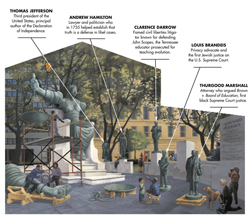Not in My Backyard
Mural by Michael Webb
Click to enlarge image
Muralist Michael Webb had already had two public art projects shot down in the upscale Philadelphia neighborhood known as Rittenhouse Square, when he was commissioned to paint a third. He fully expected that this assignment would never come to fruition either, but the reasons had nothing to do with his art.
A handful of vocal residents thought that kind of artwork belonged in other neighborhoods, Webb says, and feared how a 38-foot-long outdoor mural painted on the side of a building might look.
But the neighbors perhaps didn’t understand just whom they were dealing with in this case. Philly litigator Paul Rosen had commissioned Courtyard of Justice on behalf of his law firm’s charitable foundation and was not going to give up on it without a fight.
In addition to the neighborhood protests, the Philadelphia Historical Commission claimed that the mural would alter part of a historic building, according to news reports. The wall on which the mural was intended to go overlooked a parking lot and had previously been covered in graffiti.
But the commission had “no authority over an exposed wall that has no historic significance,” says Rosen. “Painting is not an alteration under the code. And if it were, it is not altering a historic part of the building.”
The original concept for the mural was a statue of Lady Justice broken into pieces, Webb says. Rosen loved it and asked Webb to add five significant legal figures to the mural.
And after a nearly yearlong tussle, Courtyard of Justice was installed in December.
“People love it, as far as I can tell,” Webb says. “Whenever I go back there to photograph it, the parking lot attendants always tell me that everyone always comments on it, and it’s always positive.”




